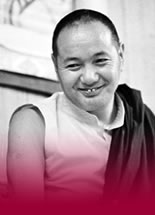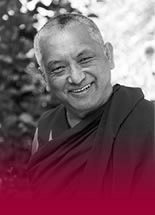35 years serving my Lamas
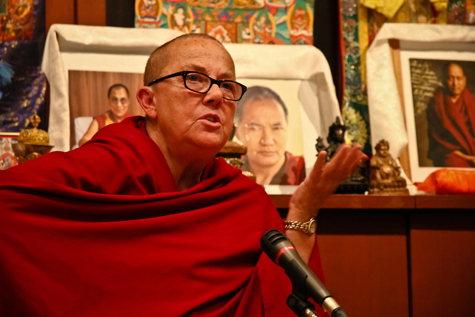
Ven. Robina Courtin interviewed by Kate Macdonald (July 2011 & February 2013)
Since discovering the Buddhist path and ordaining as a nun in 1978 – she celebrated 35 years as a nun on February 9, 2013 – Ven. Robina has worked full time for her heart lamas, Lama Thubten Yeshe and Lama Zopa Rinpoche, and their Foundation for the Preservation of the Mahayana Tradition.
At Wisdom Publications between 1978 and 1987 she oversaw at various times its design, production, and editorial activities. Also at Wisdom, she co-edited two issues of Wisdom Magazine – the forerunner of FPMT’s Mandala Magazine, which she edited from 1994 until 2000. She was executive director of Liberation Prison Project from 1996 until 2009, establishing it as a non-profit in both the US and Australia. She has edited numerous books of the lamas, including Becoming the Compassion Buddha, Bliss of Inner Fire and Dear Lama Zopa; has been the spiritual program coordinator at various centers; and since 1987 has taught at FPMT centers worldwide, including serving as the resident teacher at Tushita Meditation Centre in Dharamsala in 2010. These days she travels throughout the year, teaching at the centers, and edits for publication the lamas’ teachings.
Known for her extraordinary energy and fiery compassion, Ven. Robina’s life and work have been the subject of documentary films Chasing Buddha and Key to Freedom.
Having worked for Ven. Robina in various capacities since 2006, I have had the great privilege to see that extraordinary energy and compassion first-hand. But it is perhaps her fearless approach to offering the Dharma andgenerous, entrepreneurial spirit that I have found the most inspiring.
Rather than taking the traditional non-profit approach to raising funds for Liberation Prison Project, for example – which at its peak had a full-time paid staff of nine in two countries and a monthly budget of US$40,000 – Ven. Robina decided to use commerce instead: investments in start-ups, buying and selling properties, producing calendars, leading pilgrimages, holding cocktail party auctions, organizing conferences. She and her Bodhichitta Trust offered some 1.86 million dollars to LPP during the 14 years that she oversaw its activities.
During breaks in her teaching schedule, I had the opportunity to talk to Ven. Robina about the past 35 years of service to Lama and Rinpoche; how she developed this entrepreneurial spirit and the attitude to always think of giving and to always give the best; and about Sherab Plaza: her vision for a six-acre site in San Francisco and other cities whose commercial activities will support various Dharma activities, including a Buddhist university, school, a monastery for monks and nuns, as well as housing for the homeless.
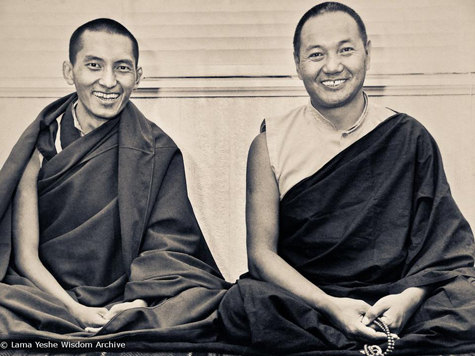
Lama Zopa Rinpoche (left) and Lama Thubten Yeshe in New Zealand in 1975 during a two-week course given at Waikanae near Wellington. Photo Lama Yeshe Wisdom Archive.
Ven. Robina, when did you start working for Lama and Rinpoche?
I’ve been working for Lama Yeshe and Lama Zopa Rinpoche since I met them really – well, not quite. I met them in 1976, at Chenrezig Institute in Queensland. I did the one-month lam-rim course with Rinpoche, followed by a month-long retreat that started with an initiation from Lama into Chenrezig and then two weeks of commentary on a text by His Holiness the Dalai Lama. I like to do things so while I was there for those two months – meditation didn’t much appeal to me – I volunteered to transcribe the teachings. I wasn’t technically employed, but I felt like it was my job, that I belonged.
When I went back to Melbourne after the course I worked for Ven. Bonnie at Tara Institute, typing and producing at my family’s printing company an edition of The Wish-fulfilling Sun, a compilation of lam-rim advice by Rinpoche, which I presented to Lama the following year at Chenrezig again when I requested Lama to be my guru. (Well, I didn’t actually request; I didn’t know we were supposed to. I informed Lama that he was my guru! “Yes, I know dear,” Lama said.)
I went to Kopan Monastery in Kathmandu for the November Course [the annual month-long courses given by Lama Zopa Rinpoche since 1972] in 1977 and immediately, again, went straight to the publishing activities. It’s what I’d done much of my life: I’ve always been on the propaganda side of things. And when I got ordained, in February 1978, Nick Ribush, who was running the publishing activities at Kopan, had already asked me to work for him.
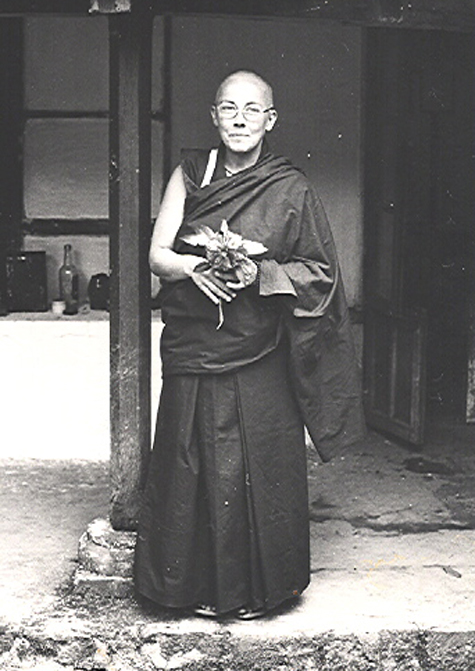
On March 9, 1978 at Tushita Meditation Centre in Dharamsala Ven. Robina received the 36 novice ordination vows from Tarab Tulku. She had arrived recently from Kopan Monastery in Kathmandu, where she'd taken rabjung vows with Lama Zopa Rinpoche on February 9. Photo Sylvia Wetzel.
And why did you choose to work, as opposed to say do retreat or study?
The idea of “studying” in the beginning didn’t make sense to me. Study what? I had no idea. The idea of meditating, what looked to me like just sitting still: I couldn’t see the benefit of that. But working on my mind, attempting to apply to my life the laws of karma, I had no problem with that: it made sense to me. But always in the context of action, doing things. I liked the idea of doing things.
I remember when I first became a nun, I had this very strong wish, incredibly strong, powerful, like an atomic bomb in me, this wish to do something. And of course, the work that came in front of me right then was publishing. I remember when Nick asked me, during my first months at Kopan, to work for Wisdom “for a year,” I remember thinking, “Why is he asking me? It’s my job!”
After I accepted Nick's invitation, I moved with him to Delhi soon after I got ordained, where Lama had appointed him director of the new center there, Tushita. There, we worked on developing a list of titles to publish and I researched printers, but then Lama moved all his main activities to his center in the north of England, Manjushri Institute. I went there to work with the new director of Wisdom, Ngawang Chotak.

Manjushri Institute, the former FPMT center in Cumbria, in the Lake District, founded by Lama in 1976, and the base for Wisdom Publications from 1978 to 1983. Photo Lama Yeshe Wisdom Archive.
Could you tell me about how your ideas evolved working at Wisdom?
I always remember Lama Yeshe would say “Think big!” and “Be professional!” They really resonated for me. I really wanted to be this way.
In the 70s when the Westerners first met Buddhism and went to India and Nepal and saw all these Tibetans wearing long dresses and bright colors and the men with their long hair and wearing earrings, for us they looked like hippies. It was just this really ridiculous misconception in Western people’s minds that “hippie” and Buddhism were similar. In fact, Tibetans are really conservative people.
And because we’d be hearing about “renunciation” we’d think it meant running around looking ugly and having no money. Or not caring about how things are done.
What “professional” means is you do things properly, you do things nicely, you do things according to the culture. I remember watching Jacie Keeley, Lama’s secretary in the 1980s. Jacie took Lama seriously. She would wear nice things. There she was at Kopan where everyone was wearing their hippie clothes and she’d have her nice stockings on, high heels, lipstick, earrings, perfume, looking professional. I admired her approach.
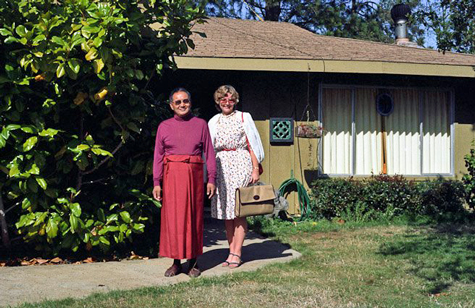
Lama Yeshe and Jacie Keeley in 1983. Jacie served as Lama's secretary from 1979 to 1984. Photo Lama Yeshe Wisdom Archive.
But why is it so important to look nice? Isn’t it ultimately what’s on the inside that counts?
I remember Grace Kelly saying, “Of course I have to look beautiful, people have to look at me.” It’s insulting to others to look ugly. It’s insulting to offer a book that’s ugly, that’s not well designed. One way to make human beings happy is presenting things beautifully. A beautiful meal, a beautifully designed book, a beautiful building. We’re human beings, we have a mind, we want to be pleased. How you please people is being kind and offering beautiful things to them. For me this is what I got from Lama, so clear, you know. This is the attitude of the bodhisattva. I couldn’t articulate it then – I didn’t know the teachings well enough – but it made sense to me.
So when I started to do the work at Wisdom, I tried to do the very best. I’d always hear Lama, these mantras in my mind: think big and be professional. To do things the best way possible. I took on the design and production of the books, so doing the books, making them as elegant as possible. And, of course, it makes business sense. If you’re trying to sell something – and we were joining the world of book production and distribution – it needs to stand out, to attract people.
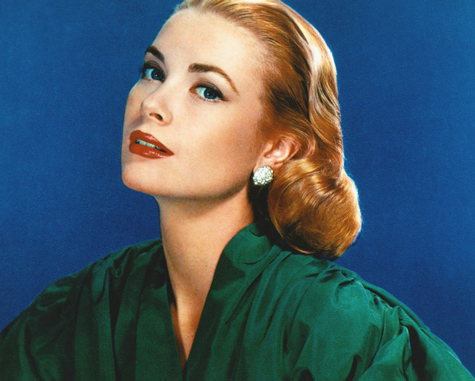
"I remember Grace Kelly saying, 'Of course I have to look beautiful, people have to look at me.'"
I’d been in printing and publishing all my life, but I needed to familiarize myself with the book industry, learn how to do things properly. So I’d go to bookstores and I’d look at books and I’d check the design; I’d check the binding, the paper, the sizes. I’d check up on distribution, how they did things. My feeling was, once you’ve learned that, then you can be creative, you can improvise. Then you can really see, okay what do I want to do with this? How can I really be creative? How do you make this the very best? And not to cut corners: to really want to do it the best way possible. I wanted to make the books look the best. The writing to be the best, the design the best, the paper to be the best. To be professional. To do it well, to do it really well.
So I think from the very beginning what I started to learn about the mind was the need to not be afraid. On the one side to learn how things are done conventionally, but on the other side not to be afraid to be creative, not to be afraid to go beyond the usual ways that people do things. Always to really know in your mind what you really wanted. So to have these two things: learn to know how things are done, but to really know where you want to go with it yourself. And have the confidence to do that. This is what I got from Lama.
From the very beginning, Lama hardly ever told me what to do. In this way he forced me to look into myself, to learn to find out myself what to do. To be brave about it.
I had such enthusiasm to learn all the different aspects of publishing. I loved to do the accounts, loved to do the design part, completely enjoying to do the editing part; learning how to edit properly. Looking at the way books were done and then learning how to do it.
I remember being really inspired by Penguin. Since the 1930s Penguin revolutionized publishing by coming up with simple, elegant little paperbacks. And then in the 1940s they started their uniform cover designs using colors to distinguish the series. Instantly recognizable. Orange for general books, blue for I think artistic books, green was used for, I forget now, crime stories. It worked. So based on that we came up with a concept at Wisdom of Basic Books, Intermediate Books and Advanced Books. It seemed very clear to me that because Buddhism’s something you’re trying to learn, the books had to be structured, like a course, and immediately recognizable. So we had orange for basic, white intermediate, and dark blue for the advanced.

Ven. Robina's design concept of the use of color during her time at Wisdom Publications was inspired by Penguin Books. "It seemed very clear to me that because Buddhism’s something you’re trying to learn, the books had to be structured, like a course, and immediately recognizable."
I also learned about distribution. The very first book we sold in bookstores was Silent Mind, Holy Mind, a little hardback book, Lama Yeshe’s teachings on Christmas that he used to give every year at Kopan. We printed 5,000 copies and I’d go around to all the shops in London, selling it; we didn’t have a distribution company yet. I really enjoyed doing all aspects of publishing, wanting to do each part, things that I’d never done before.
And then there was the thinking big component. At the time I became involved the FPMT was international but relatively small. There were about 13 centers. I like the big picture, so at Wisdom I tried to express that. Think big means think universal. I’d come from Australia, here I was living in England. I’d been to Nepal, done a bit of traveling already before I became a nun. I knew that the world is a small place actually. So I’d think, “Where’s the best place to print in the world? Where’s the cheapest?" Not only for production but for shipping and distribution as well. And where’s the most central; after all, we distributed to Europe, the Pacific, Asia, the Americas. Asia was the cheapest, and central. So I’d go to Hong Kong to find printers and stay with Peter Kedge, Lama’s first attendant, who’d started doing business there.
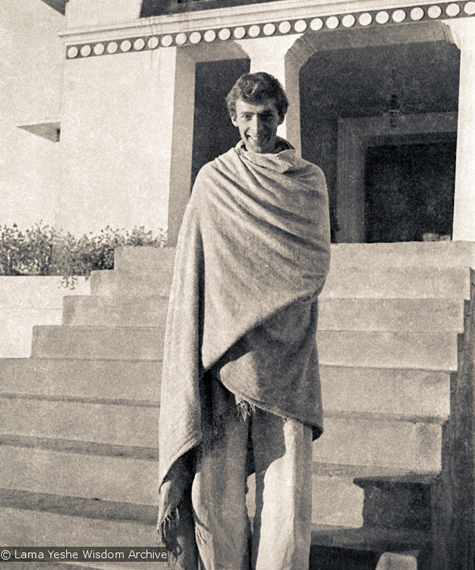
Peter Kedge at Kopan in 1972. Peter moved to Hong Kong in 1979 to start a business to support FPMT. "He didn’t just think, 'Well, who’s going to give us money? Where are the donations coming from?' He decided he’d do something himself. I like that thinking. That inspired me." Photo Lama Yeshe Wisdom Archive.
We not only produced books but thousands of posters of deities, for example, as well – Andy Weber’s and Peter Iseli’s art – you still see those posters on people’s walls 30 years later. For two years in a row we produced date books featuring the art of the Kopan monks and we did them in four languages and distributed them worldwide. We produced thousands of postcards of deities and greeting cards.
Lama had students in various countries – Germany, Italy, France, Spain – who also wanted to translate and publish the teachings. So we worked together. When I arrived at Wisdom, I commissioned Peter Iseli to design a logo for Wisdom – the one that’s still used today. We all agreed that everyone should use it: we were all FPMT publishing, after all. And Chiara Luce in Italy, Dharma Ediciones in Spain, and Diamant Verlag in Germany, like Wisdom, still do.
Always the big picture. During that time we produced a directory of all FPMT activities: white pages for the centers and yellow for the business activities: by then there were several. And in 1982, in preparation for His Holiness the Dalai Lama's visit to France, Italy, and Spain, that Lama Yeshe and the FPMT co-hosted, I spent time in Hong Kong writing and having translated into four languages the first brochure about FPMT and its worldwide activities, which we produced 10,000 copies of and distributed to all-comers at His Holiness’s events.
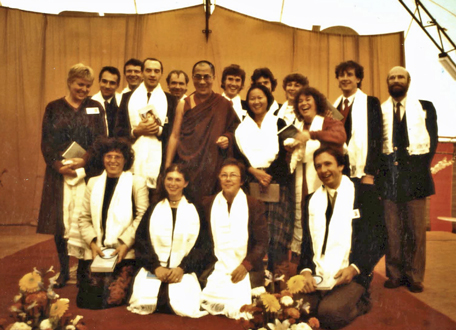
Ven. Robina and other FPMT bodyguards with His Holiness the Dalai Lama during the teachings organized by Lama Yeshe in France, Italy and Spain in October 1982. Photo Gun Cissé.
I could see from Lama and his amazing activities that you need to be fearless, courageous. You have the vision first, the thought, and then you do it. It’s so easy to stay stuck in our own little ways, we’re so scared to do something new, we’re scared to think differently. We’re scared of what the world thinks. That’s what I learned from Lama: to be brave, do things well, and think differently, out of the box.
I see at the centers around the world, one of our commonest mistakes is, “Oh, we can’t afford it, we haven’t got the money,” so always short-changing ourselves, always holding back. It’s so important to be optimistic, to know we can do it, we can find the means to do it; to do it well, to do it the best, and to do it in a really creative, unusual way.
So did your ideas for commercial activity to support the Dharma also come from Lama?
Yes, for sure, although it would be another 15 years before the opportunity arose to put them into practice. As I mentioned Peter Kedge went off to Hong Kong to start business: that inspired me too. Peter had been serving Lama since 1972 or so. In 1975, Lama named his work The Foundation for the Preservation of the Mahayana Tradition. There’s Peter, helping Lama grow this organization and he realizes there’s no money. And so what I was really impressed with was that he didn’t just think, “Well, who’s going to give us money? Where are the donations coming from?” He decided he’d do something himself. So in 1979 he went to Hong Kong and started a business. I like that thinking. That inspired me. And not only Peter. From the beginning of Lama’s work at Kopan, Lama had his students, Marcel Bertels and Roger Kunsang, working in Kathmandu at commercial activities. Lama understood this so clearly.

Marcel Bertels with Lama Yeshe (left) and Lama Zopa Rinpoche (right) in Amsterdam in 1979. The Lamas had Marcel doing business from day one in Kathmandu. Photo by Jan-Paul Kool. Photo Lama Yeshe Wisdom Archive.
From this, the seed of thinking commercially began to flourish in my mind, seeing the benefit of commerce. Then in 1987, after 10 years at Wisdom, Rinpoche told me to go and teach, which had never occurred to me before. I didn’t know that much Dharma, I’d edited books, I’d done a couple of years of the Geshe Programme at Manjushri Institute; it had been just 12 years since I’d been a Buddhist.
So you did study when you were at Manjushri Institute, doing the Geshe Programme. Why did you decide to study then? Why did you change your mind?
In 1979 Lama had invited Geshe Jampa Tegchog, one of his friends from Sera Je Monastic University, to come to Manjushri to start a modified program for educating us Westerners in the studies they had undergone in Tibet.
That first year, 1979, I noticed the students, about 20 of them, going to these classes every day, but I had zero interest. I was fully involved with developing Wisdom Publications. Then, just before the new term started later that year, I heard someone mention one of the texts they were studying, Collected Topicsor Dura in Tibetan; I discovered it’s the first text that the monks study as little boys. Something stirred in me. I went to see Geshe Tegchog and asked him if I could come to some of the classes – they were held five days a week in Geshe-la’s room. I told him that I probably couldn’t come to all of them as I was busy with Wisdom.
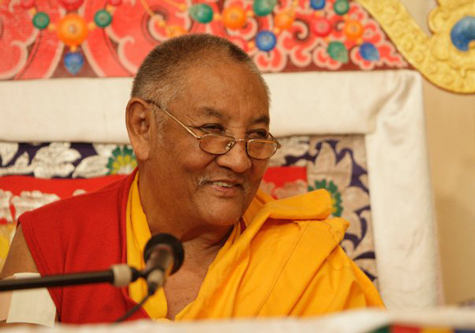
Former Sera Jey Abbot Khensur Geshe Jampa Tegchog, Ven. Robina's main philosophy teacher at Manjushri Institute in England from 1979 to 1982. Photo Land of Medicine Buddha.
Well, all I know is that from the first day, I blissed out! I was so happy hearing these teachings. It was as if I had discovered for the first time in my life what my mind really wanted. Actually, all my life I had been looking for a worldview. The lam-rim teachings that I heard from Lama Zopa Rinpoche at Chenrezig didn’t do that for me – I knew intuitively that it was my path, I knew I’d found my home, I knew I wanted to be a nun, but I didn’t understand a word Rinpoche said! I could hear the words, but I couldn’t process this arcane presentation of ideas. “Where’s the Buddhism?” I kept asking myself.
But Du-ra! I was in heaven. I did two years and studied some basic texts: Du-ra, Drub-ta (Buddhist tenets), Lo-rig (Buddhist psychology), and Ta-rig (Buddhist logic). We did exams every semester; I memorized; I studied properly for the first time in my life. Now, I can’t imagine understanding Dharma without it. It was the perfect base for all teachings that I heard later.
And what I learned is that the clarity and rigorous logic and precision and depth of analysis that this study demands – and, crucially, that make Dharma practice successful – is the same clarity and logic and precision and analysis that you need to manage an organization or build a house or produce a book. Dharma’s not in the sky! It’s right in front of us.
Could you talk a little bit about when Rinpoche asked you to teach, about traveling to all the centers, how your ideas evolved then?
My ideas about thinking big, being professional, doing things well, doing things in a very creative way, really began to crystalize when I started going around the centers after I left Wisdom. In 1987 I was at Vajrayana Institute in Sydney for a year or so. Then a year at Chenrezig Institute, spiritual program coordinator there. Then a year in Germany, Arya Tara Institut; in Delhi, the spiritual program coordinator there. I began to see the way we all worked.
First of all, however small or big, the centers are astonishing; what the centers accomplish is incredible. I think of the prison project, you know, we began with one letter from one prisoner and I think over the 14 years that I was there – and it’s continuing now – we were getting up to a thousand letters a month from prisoners. We probably had 25,000 individual people write to us and we offered countless thousands of books to them. So each of those people, even if they just heard the word “Buddha,” even if they just heard the words “You can change,” even if they just heard, you know, the idea that they can develop some qualities in their mind, how marvelous, how fantastic! And I think every center’s the same. No matter how big or how small, the fact that it exists and someone is struggling to provide a little class on how to meditate once a month even, I think that’s amazing. It’s fantastic. So much longterm benefit.
So, going around to all the different centers, I observed this, but also noticed other things: one, the struggle for money, always the struggle with money; two: not knowing how to be a good manager. And, of course, the two are closely linked. And three, the way things were presented: often old junky furniture, not nicely put together, and not so welcoming. As if, somehow, now that we’re Buddhist, elegant furniture or professional management or money are just not important.
Lama would scoff at us! At the first Enlightened Experience Celebration that Lama organized in 1982, he was so heavy with us monks and nuns. There we were, wearing ugly old robes thinking we’re being renounced: it doesn’t matter how we look, we thought. As Lama said, in the West, it’s not the same as in Tibet where people admire a person looking like a beggar. In the West we don’t appreciate that. You look at a homeless person, he’s not appreciated. If we wanted people to respect Buddhism, this new thing in the West, then they needed to see good examples: us looking respectable.
I remember, too, later in 1982, in London, when Harvey Horrocks – at the time, Manjushri Institute’s director – and I were Lama’s attendants for 10 days or so. I was taking Lama back to his hotel room when this woman came out of the elevator, the scent of her perfume wafting past us. Lama said to me, “Hm, she smells nice. Not like you – you smell like a toilet! Just joking. . .” Well, Lama was right. I didn’t take care of my body, not because I was renounced but because I was too self-absorbed and wasn’t aware of the impact I had on others. I really paid attention after that.
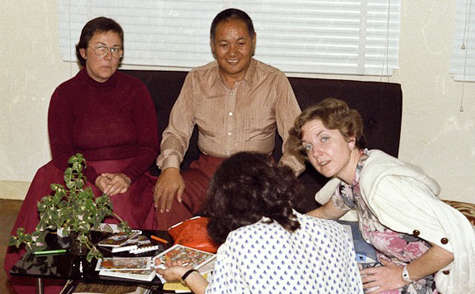
Lama Yeshe (center) with Ven. Robina (left), Jacie Keeley (right) and Nicole Kedge (center, with her back to the camera), in Hong Kong in 1982. Lama is in layclothes because he was about to travel to Tibet and wasn't able to go in robes.
The management component is a huge one, in my mind. The success or failure of the center, just like any organization, largely depends upon skillful management. What I saw again and again was that just because we might have the karma to run a center doesn’t mean we have the skill to do it. I heard that Rinpoche said to one director once, “You think you’ve got this job because you’re good at it? No, you’ve got this job because you created the karma to do it.” That speaks volumes! We tend to see “director” as self-existent, “Oh, it came out beneficial to run the center.” But if we don’t know how, we have to learn, don’t we? If Rinpoche had appointed me to design a new center building, I would certainly have to go and learn how to be an architect; otherwise, what a mess! Well, the same with management: it’s a real skill, and needs to be learned. We don’t expect a non-architect to design our house or a non-accountant to do our accounts. So, if we don’t know how to manage, we need to train.
So when you started the prison project, did you study how to be a good manager? Could you talk about the prison project and how you ran it?
In 1996 the prison work began, first when I was editor of Mandala, and later as its own entity. A prisoner wrote to FPMT and the letter landed on my desk. Arturo, a young Mexican from Los Angeles, who’d read Lama Yeshe’s Introduction to Tantra and was very moved by the teachings on compassion. And so I wrote back to him and that was the beginning. By 2000 I’d finished as editor of Mandala and Lama Zopa Rinpoche gave the prison work a name, Liberation Prison Project, and in 2001 we incorporated as a 501(c)(3) non-profit, with me as the executive director.
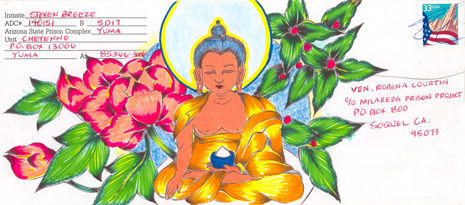
One of more than 25,000 letters Liberation Prison Project received from people in prison between 1996 and 2009. When Ven. Robina first began receiving letters in 1996 she called the work she was doing "Milarepa Prison Project," after the Buddhist saint and practitioner Jetsun Milarepa. In 2000, Rinpoche named the project "Liberation Prison Project."
When I first ran it, I had an intuitive feeling for running things – I like to make things happen. But I needed to learn how to be a good manager. I read lots of books about CEOs; learned about the laws; studied our non-profit bylaws in depth; talked to lawyers. I really wanted to conquer it, to understand what makes a good manager. I learned that you have to be brave – again. You need to stand up and be confident, see the potential of your staff, help them develop it, inspire them, educate them. I realized that people might be devoted to the lamas but if they don’t like you, they won’t do a good job. That’s hard. Again, Lama: be professional, think big. And you need a clear structure, clear lines of responsibility and authority. So often in centers I see that there is disharmony simply because there is no clear structure; no one’s clear about who does what. Or there is too much talk, too many meetings, too many cooks spoiling the broth, not enough action. And, of course, not enough vision, not enough confidence.
But always one of the main struggles everywhere is in relation to money and how to get it. There’s this assumption that because we’re non-profit, because we’re religious, we’re supposed to beg for money. The root of this in our European culture is the noble tradition of charitable work; and the tradition in the East and West, so ingrained, that you can’t charge for religious work. That’s perfect! So we assume that we need to beg.
It was clear to me that in the West, begging simply doesn’t work. No one likes giving money. We’re not like the Asians, it seems. In Taiwan the monasteries are huge because the lay people totally support them, and all the monasteries give everything back to the lay people. It seems to work beautifully there.
Well, what works in the West? It’s pretty obvious that commerce works. You don’t have to beg someone to give money when you go to a café to buy a coffee. Because we want our coffee, we are happy to give the extra money tacked onto the end of the costs, which is the profit; we don’t mind that. So it seems so clear to me that commerce is something that we know well in the West; and we’re geniuses at it.
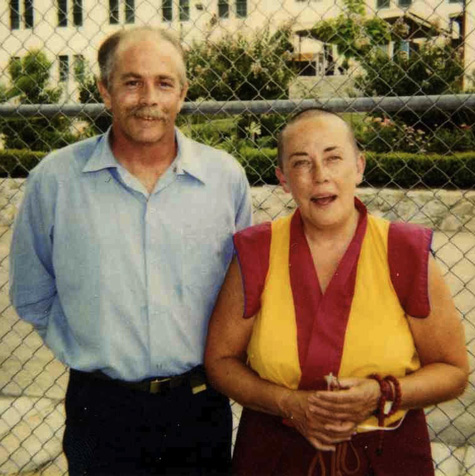
Ven. Robina visiting with Paul Dewey, one of many thousands of prisoners who became practitioners as a result of the work of Liberation Prison Project, at Folsom Prison, outside Sacramento in Northern California, in 1997. Paul was released in 2010 and lives in Los Angeles.
That’s why I was so impressed by Peter, that he made a decision to make money; if he didn’t do it, who would? So he started doing business. And where do you go for business, you know? He decided to go to Hong Kong: a center of commerce, for sure. Another old student, Marcel Bertels, as well: he’s run business for years in Kathmandu that supports Dharma activity. This hugely helped me to think outside the box, in relation to what a center is and how to bring in the dollars. I began to grow in my own mind, to think, “Well, how would I do a center?” How would I do a center if I had to run one, what would I do? What would I have?
So then I’d think, if I were running a center, I’d have a Buddhist book café. I’d have a spa, I’d do massage. And how would I grow this? How would I develop this? I’d have a few condos – I was in the States by now – and then sell them. I’d imagine a country Dharma center with a few acres of land, say. They could easily use some of that land to build really nice apartments and then sell them to people to get the income. So this idea began to grow in my mind. I didn’t talk about it to anyone, just thought it out, made aspirations.
And these aspirations, this idea, this was the beginning of Sherab Plaza, correct?
Yes. Now that I was running an FPMT activity, empowered by Rinpoche to run one of his organizations, I thought, okay, why can’t I do something like this? There’s nothing written anywhere that says a director of an FPMT center can’t do business to support its activities. The prison project was based in San Francisco by now. And my friend Tove Beatty, who did our accounts and was our operations person, I mentioned this idea to her, this concept of a Dharma center supported by commercial activity, and she said, “Great, I’ve got these architect friends, why don’t we invite them for lunch?”
Her friend Kasey was the development director at a firm, and we took one of the partners to lunch and presented this vague idea about using commerce to support non-profit. And he was really impressed. He really liked the idea. Then Kasey moved to another architect called Smith Group and they came on board, they were inspired it, and they offered us $50,000 worth of pro-bono work. So for about a year or two we just started growing this plan, growing this idea; it was just an idea.
And what I learned from this so hugely was how everything starts with an idea. It’s so obvious. As Lama Zopa Rinpoche says, “Everything exists on the tip of the wish.” This vague notion of using commerce: a property, a few condos, sell them, get the money, book café, spa – all this bringing in the dollars, which would then fully support the Dharma center so the Dharma center could completely give to its students. This was the unformed idea in my mind.
The architects were moved by the idea. They introduced us to a project director, he was moved by the idea. They introduced us to Staubach, a big real estate company. They were moved by the idea and one of their guys, Toma Barylak, came on board. There was Toma, Kasey, these different people. They introduced us to a zoning lawyer, Andrew Junius, one of the best in San Francisco.
By 2005 it had began to really burst into life. It was fascinating. It began with this thought in my mind. And it grew. And then I’d meet these people. And each of them hearing about it was moved by the idea and helped it move one step forward, another step forward. And these are people in the commercial world, people running billion-dollar projects. Smith Group, apparently one of the biggest architecture firms in the States; Staubach, one of the big real estate companies. And all these people moved by this idea, really touched by it. I’d put this idea out. We would have meetings and each person would add their little piece until it manifested itself in this vision, this plan.
I remember vividly one of the meetings we had, one of the team, he’d been a project developer for billion-dollar projects, and I brought up the idea of building condos to help bring in the money. He leaned forward and said, “Robina, you can build enough stuff to pay for everything.”
So what I was learning from this was, why hold back? I really realized that we’re afraid to have ideas. Because as soon as we hear an idea that’s outside our comfort zone, we say, “Oh no, we can’t do that, I haven’t got the money.” Therefore we don’t even think it, we don’t even have enough courage to think it. So what I learned from this was: it doesn’t cost a penny to have an idea. You have to have an idea first. And the more clear the idea, the more clear vision, the more likely you are to be successful.
This is the simple idea behind the concept of karma. Karma literally means “intention” or “action”; intentional action. That’s the mind, isn’t it? And this is exactly one of the approaches of Lord Buddha’s most sophisticated level of practice as taught in tantra. We visualize, imagine, “bringing the end result into the present.” So the more clear you can visualize exactly what a buddha is, how a buddha functions, and you replicate that in your meditation, well that’s a cause for becoming that buddha. So this is so clear. We need to bring this concept into ordinary daily life.
So people came on board, and we cultivated this view until it grew into this vision we called Sherab Plaza. I really wanted the word “plaza,” because I think it sounds nice for English ears. And I wanted a Tibetan word to go with it. I would brainstorm with Toma, the real estate guy, who was really enthusiastic, going through different Tibetan words until we found one that went nicely with the word “plaza.” We decided sherab, which means wisdom, sounded good. Sherab Plaza.
So we thought, okay, let’s just back into the plan, come up with what we think we’d like, and then see how much money we need for this. The idea crystallized: we imagined a six-acre site, downtown in some big city. And because we were in San Francisco it seemed reasonable to start there. And in fact we found the perfect site; we presented about 10 to Rinpoche and he said that this was the very best, but we “didn’t have the merit,” Rinpoche said.
Anyway, on the commercial side we’d have lots and lots of condominiums for sale and for time-share. And one of the main ways of bringing in funding would be to manage the time-share. We’d have a car-parking business below. A thousand car-parks, sell those, and manage them. And then we’d have a hotel, book café, spa, gym, restaurants, conference center, other shops. And this would bring in all the dollars, which would fully support the Dharma, which would consist of a monastery for 100 monks and nuns, give them all their own homes. A cathedral. In my mind, why not think like Westerners? We’d have a cathedral, not a gompa. At the time Michelle Stewart, who was running San Francisco FPMT center Tse Chen Ling, where I was based with the prison project at the time, she and I were working together on this idea. And the idea was to have Tse Chen Ling there and it would be a university, like they’re doing now at Maitripa College in Portland. And there would be Liberation Prison Project, which I was running at the time, a big staff supporting that. A school for children. Then we’d have, also, housing for homeless people offsite. And there’d be an acre park in the middle.
And then we looked at how much money we would need to make all this happen. So we started with the end result and backed into it. Our money guy, a friend of Toma’s, crunched the numbers and it came to about 700 million dollars. This was in 2006, the numbers have certainly changed by now.
Sure, it looks insane. But an idea costs nothing. And this is what people are doing every day, all the time. Our team all worked on such projects, so for them it wasn’t insane. They were the ones who inspired me to keep moving; they were honored to be part of such a project.
I prepared a 25pp PowerPoint and presented it to Ven. Roger for Lama Zopa Rinpoche. Rinpoche was delighted! Roger said I’d probably have to wait for months to hear back because Rinpoche would need to check on the people, etc. etc., but Rinpoche did a divination that evening. Rinpoche said that if I “continue my thinking, it will be successful. . . Whether small success or big success, will be achieved.” And Roger said that Rinpoche didn’t need to check on anything but the land, that I could go ahead. I was so empowered by that!
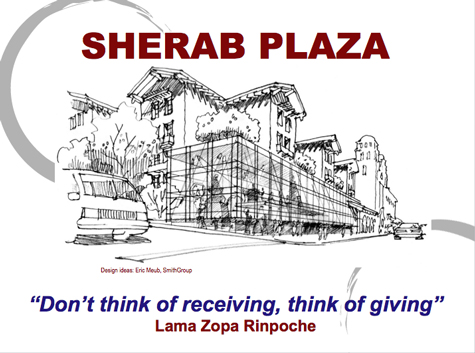
One of many drawings of Sherab Plaza. Design ideas by Eric Meub, Smith Group.
Lama Zopa Rinpoche's advice: “Do not think of receiving, think of giving" became the motto for Sherab Plaza and all Ven. Robina's work for her lamas. "So clear in my mind that if Lama Zopa Rinpoche can think this way and if he is my lama, then of course I have to replicate him. Why else would he be showing this example?"
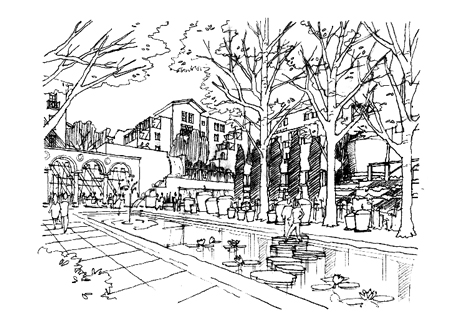
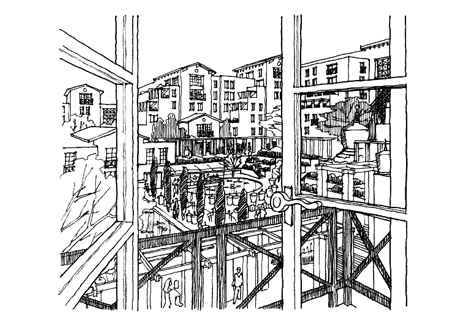
That was in 2006. So far, nothing further has happened. We’ve had many obstacles, many things go wrong. Rinpoche gave us many practices, and we have done all of them. The recitation of a Guru Rinpoche prayer to remove obstacles, for one. We’ve done more than a million of those. We talked about Sherab Plaza in our Liberation Prison Project newsletter, so the prisoners got very excited and involved and counted their prayers. And wealth vases: we’ve done two sets. And statues of wealth buddhas: a one-foot Dzhambala, a three-foot Ganapati, and a five-foot Nam-tu-tse, which is another version of Dzambhala, it seems. We commissioned Peter Griffin, Lama Zopa Rinpoche’s student, a statue-maker in England. They took a couple of years and cost around $70,000. And what made this all possible was a donation from one monk at Vajrapani, Jangchup Phegey, one main donor. He gave us about $115,000, which helped pay the salary of our one employee for a brief time, Keisha Roberts, as well as the statues.
In January this year we had the statues consecrated. Denice Macy at Land of Medicine Buddha has kindly agreed to the statues staying there, and Geshe Dakpa, the resident lama in San Francisco, kindly came to LMB and lead pujas all day. A whole group of people attended. A marvelous event. A nice next step.
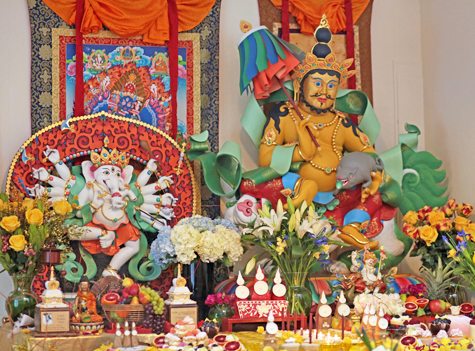
The three statues Rinpoche advised be made for the success of Sherab Plaza were consecrated January 18, 2013 at Land of Medicine Buddha in California. From left: a three-foot Ganapati, five-foot Nam-tu-se; and one-foot Dzambhala (just under Nam-tu-se's left foot). Photo Ven. Thubten Kunsang.
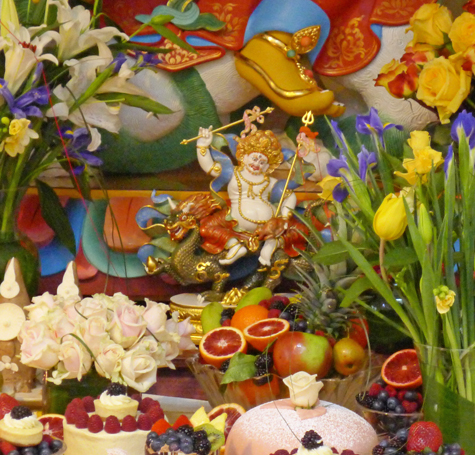
The one-foot Dzambahla.
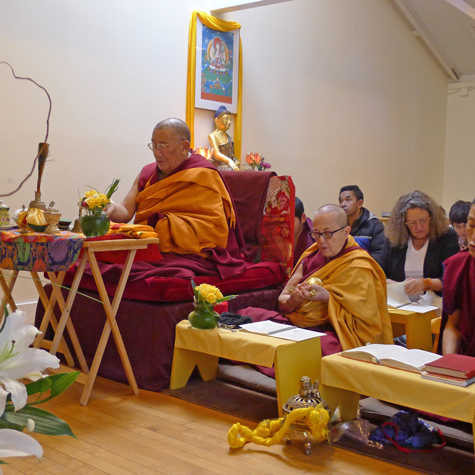
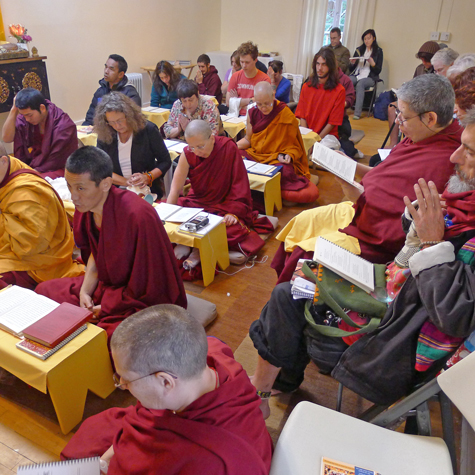
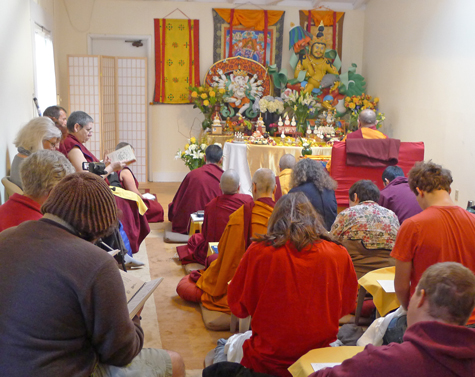
So now here we are in 2013, nothing is happening on the surface, but as far as I am concerned the idea is alive and strong. I offer mandalas daily for its success, for it to manifest. Whether it’s this life or next life, it doesn’t really matter. I’d love to do Sherab Plazas all over the world. Have one in New York, one in Sydney, one in London. We’ve done the practices Rinpoche recommended. And the land in San Francisco is still vacant, so who know what will happen!
So what I learned from this, is, again, to think big and be professional. And this is also exactly how Lama Zopa Rinpoche thinks. Rinpoche doesn’t use those same words “think big,” but if you look at Rinpoche’s projects, he’s unbelievable, nothing limits his thinking, he’s limitless, fearless in his thinking. And if they’re my lamas how can I not think like this?
And to always offer the best, to be as generous as possible – did this come from Rinpoche as well? You were always urging us to think this way at LPP.
Yes, so the other aspect, which is very much reflected in Sherab Plaza, is to think generously. What I began to learn seeing all the centers, seeing the poverty mentality, seeing the fear about money, thinking we have to beg for money, what I really began to learn about this was to think generously. And this was absolutely from Lama Zopa Rinpoche. Unbelievable the aspect Lama Zopa Rinpoche shows of generosity.
This really crystallized when a very kind donor offered some money after she sold her house in Australia. She had a crystal that she wanted to put in the house to help the house sell. And she asked Rinpoche to write a mantra on it in order to help the house sell. And Rinpoche said to her “Do not think of receiving, think of giving.”
That became the motto for Sherab Plaza, for all the work I am doing. And again, so clear in my mind that if Lama Zopa Rinpoche can think this way and if he is my lama, then of course I have to replicate him. Why else would he be showing this example?
I remember when International Office was at Land of Medicine Buddha in the 1990s and I was running Mandala, we were paid $400 a month, plus given our board and keep. Then Massimo Corona became the director of International Office and he started giving us reasonable salaries, according to the world, sort of low-level non-profit salaries. And I remember deciding that I wouldn’t accept a salary. I took the salary, but then I gave it back at the end of the year I remember giving back $20,000.
I made a decision that I had to be generous as well. I had to act generously. Always in the Dharma centers we think people have to give to us. But I thought we as a center have to be generous. How can we not be generous? If we’re not generous, how do we create the cause to receive anything at all? So I began developing this real distaste for begging.
And it seemed very clear to me, if you did something really well, I learned this from Mandala, then people would be inspired by what you do and would want to support you.
I cultivated this idea with the prison project. The prisoners can’t give anything. We needed money and we started very small with a budget of $500 a month. I remember in 2001, after I’d finished Mandala, I decided that we had to pay salaries for people to be fully committed. The letters from prisoners were coming fast. I couldn’t expect people to give their time if they couldn’t work full time; nothing would ever grow. We had to be professional. So we had one, two workers I think, and our budget grew to $5,000 a month and it grew to $10,000, $20,000. And at the maximum, in 2008, I think, we had a budget of $40,000 a month.
The need was huge. We couldn’t read those letters from people in prison and not be moved to want to help. We couldn’t say, “We can’t do it, we don’t have the money.” What we thought more and more was, “We will do it, then we will find the money.” And we always did.
So of course that money has to come from somewhere. On the one side I was always trying to use commercial ideas. With the money I had been given I did investments, bought properties in Australia, rented them out, then sold them, bought some diamond shares. In 2009 three successful cocktail party-auctions raised nearly $100,000. Roughly another $100,000 was brought in by pilgrimages I lead over the years, organized by Effie Fletcher. We did a Tibetan calendar every year. Always trying to use commerce.
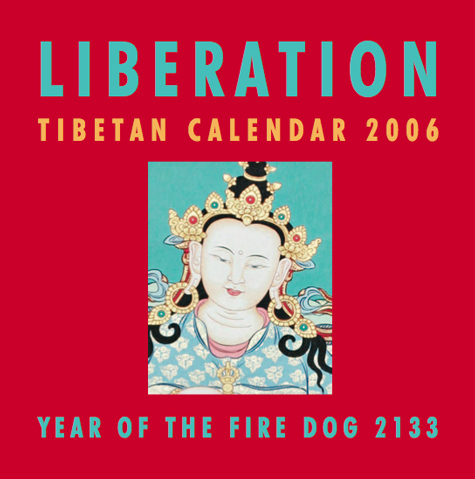
Under Ven. Robina's directorship, Mandala, the magazine of FPMT, started publishing a Tibetan lunar calendar in 1999, which was distributed worldwide. When Ven. Robina left Mandala in 2000, to fully devote herself to the prison work – "the letters from prisoners were coming fast" – LPP took over the calendar, which includes advice from Lama Zopa Rinpoche and others about various Buddhist practice days each month, favorable and unfavorable days for practice, special Buddha days, etc.
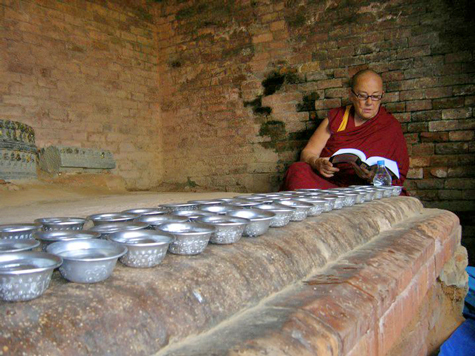
Ven. Robina at Nalanda, the ancient Buddhist university, in Bihar, India, during the 2009 Chasing Buddha Pilgrimage to Nepal and India, one of Ven. Robina's many commercial ventures to bring in funds to support FPMT.
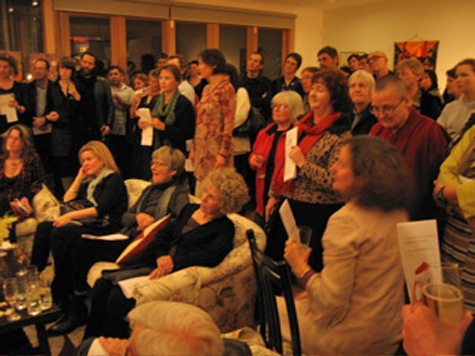
A cocktail party-auction in Melbourne in 2009 was another commercial venture – one of three parties Ven. Robina organized in Australia that year to bring in funds for LPP. Photo Julie Cattlin.
I lost a lot of money, but I made some too. Overall, for sure, yes, successful, but quite a struggle. But to me that seemed a better way to use my energy as a director, rather than begging from people and building up a database of people you can write begging letters to, that I would do commercial activity. It seems so clear to me that the merit we created by making effort to make money was far more than the effort in asking for money, expecting others to give it to us.
So I think over the 14 years that I ran the prison project, we spent a total of 2.3 million US dollars. The Bodhichitta Trust gave something like 1.86 of this, with the rest coming from donations from others. And during those years we never did a begging letter, never did the traditional way of getting money. But somehow we managed to find the money.
I could say that this policy of not begging and using commerce was successful. I ended up with debt, but including that debt, still, I think we were successful in this approach.
I’ve learned this from both lamas actually. If I look at Lama Yeshe and Lama Zopa Rinpoche, the same. And this has to be a quality of holy beings. Holy beings are limitless in their views, limitless, they’re fearless, you know. And I see in the ordinary samsaric mind, the ordinary mind, we’re afraid, we don’t think we can do it, we don’t have any enthusiasm, we don’t believe it’s possible, we can’t do this, so we hold back. So what I’ve learned from both these lamas, both my lamas, and this is the example they showed. And if this is their example, how can I not be like them? This is my job, you know, to fulfill their wishes.
So how does one begin to develop this kind of attitude? How do you learn to be brave when you don’t feel particularly courageous?
Well, first of all here we are being Buddhists, and being Mahayana Buddhists we are saying prayers every day: May I become a Buddha to benefit all sentient beings; I want to become a Buddha to benefit all sentient beings; I want to get enlightened. And if you actually think about that aspiration, it’s outrageous. So brave! Talk about think big!
The idea of becoming a mind that pervades the universe, that sees the minds of all beings, all their past, all their future, sees all their karma and has infinite empathy with every single one and has the power to manifest in trillions of forms throughout trillions of universes for trillions of eons, excuse me, if we dare to say that every day in our prayers, how absurd that we are too afraid to say, I can start a 700 million dollar project; I can start a Dharma center with stories.
We’ve really got to see what we’re saying in our prayers. It’s absurd! We just say them in a nice, religious holy way, not realizing we’re stating really powerful goals.
So if I can have the goal of becoming an enlightened being, building a 700 million dollar project is just nothing, you know. Nothing. So we have to be logical. And if we are afraid to say, “Can I build a Dharma center?” Then we never should say, “I want to become enlightened.” It’s absurd. It’s complete contradiction.
And, of course, the more we understand, as Lama Zopa Rinpoche says, that everything exists on the tip of the wish. This is the very meaning of karma.
The more we understand Buddhism, the more we study the nature of mind: that every thought is a karma, every thought leaves a seed in the mind that will ripen in the future, as the manifestation of that thought. That is the meaning of karma.
So then we can relax. Have a thought. That’s it. Have a thought, grow it every day and the thing will happen. It’s not complicated, we shouldn’t be afraid of it.
And if you’re in charge of a center or project and need to find the resources to be able to do your work, offer services, how do you do this?
And that’s how you get resources too. With the prison project we began with nothing. A letter came on my desk, there I was editing Mandala, no budget for such a thing called prisons, you know. I got a little bit of money every week myself. A letter would come, you would read the letter, you were very moved by it, you would think, well who can do this?
And as Lama Zopa says, we’ve got to cultivate the attitude of a bodhisattva. And if my lamas do this, again, if they’re in front of me, I have to try and be like them.
So Lama Zopa Rinpoche would see a letter in front of him from somebody and be moved by their needs. He wouldn’t say “I wonder who’s going to take care of this?” and give it away – it’s on his desk. So then if he does this, I must do this.
So the attitude I had was, this is on my desk, I had better take care of it. And then by the end of the year I was receiving letters from 40 prisoners. And every time another letter would come I would think, “I can’t do this, this is impossible.” But then I’d think, “It’s on my desk, I have to do it.” It was written to me, Dear Robina. I’m called Robina. I have to do it, you know.
So any money I had from donations, I’d use it for the prisoners. That money doesn’t have a label on it that it’s belonging to Robina and she can’t use it for what she wants. This is the attitude I cultivated. And, again, this is exactly the example Lama Zopa Rinpoche gives, completely. Money comes in this hand and it’s out that hand the next second. So, again, if he’s my lama, I have to replicate him. I have to duplicate his activities.
So that’s how the prison project grew. And then people came along and worked with me, we cultivated this view between us. Think of giving, don’t think of receiving.
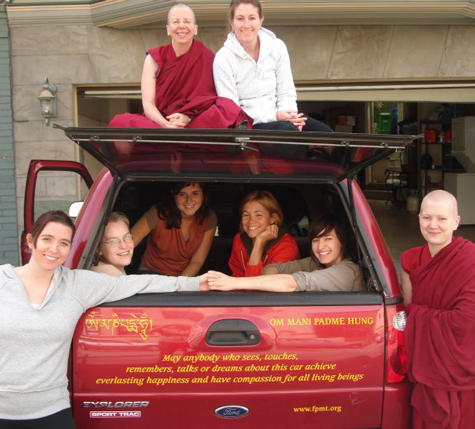
Liberation Prison Project San Franciso staff and volunteers in 2007. At its peak, when Ven. Robina was running it, LPP had a full-time paid staff of nine in two countries and a monthly budget of US$40,000.
It starts with a thought. And we have to have this courage, which is the opposite to laziness. There are three kinds of laziness: the laziness of can’t be bothered, too tired; the laziness of too busy, I’ll put it off, do it later, procrastination, one of our worst crimes; and the worst one of all: I can’t do it, not possible.
So the opposite of these are what they mean by the fourth of the bodhisattva perfections, the perfection of joyful effort, enthusiastic perseverance. This is what we need to be successful at anything in our life. We have to have this. And how to do it, by cultivating it. By thinking it. By being logical. By listening to it. By analyzing the meaning of it.
So with this we then grew into a project that was spending 10, 20, 30 even up to 40 thousand dollars a month. Somehow the money always came. We had debt, I left the prison project with the debt; I took it upon myself. But still the money is coming to pay that.
Could you talk a little bit about the Happiness & Its Causes conference we put on in San Francisco? Do you feel that was successful?
The Happiness conference was one of the many projects we did under the auspices of Sherab Plaza. It was actually a Tse Chen Ling and Liberation Prison Project activity, but it was an event of Sherab Plaza, that’s how we presented it. Michelle Stewart and I were working so hard; at least 10 of both our staffs worked solid, full time for one year, running a conference in San Francisco, Happiness & Its Causes, which was the kind of conference that Tony Steel in Sydney was running very successfully that supported Vajrayana Institute. And it was an amazing conference actually. It was a brilliant, conference, really excellent. People were so moved by it. Some of the speakers said it was one of the best conferences they’d ever done. Some 40 or 50 speakers.
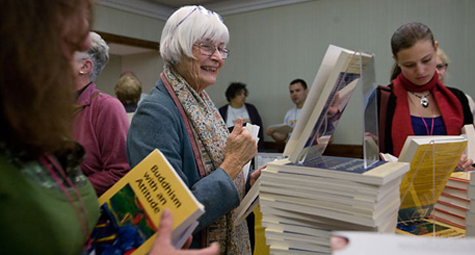
Conference-goers check out books by B. Alan Wallace and other speakers at the 2008 San Francisco Happiness & Its Causes conference, the first big event of Sherab Plaza, run by Michelle Stewart of Tse Chen Ling, and Ven. Robina of Liberation Prison Project. Photo New York Times.
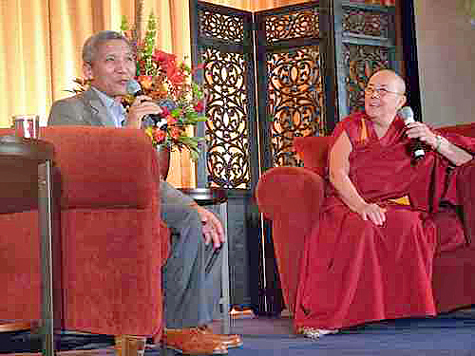
Dr. Thubten Jinpa, the principal translator for His Holiness the Dalai Lama, and one of 40-some speakers at the 2008 conference, interviewed by Ven. Robina. Photo Sarah Brooks.
We worked so hard on that conference. But we lost money on it. Because I worked full-time for one year, I had no time to bring money in for the prison project, so I borrowed money which is how come we ended up with debt and the same with Tse Chen Ling. But I think that shouldn’t be the criterion of failure. There will always be obstacles to success, especially if the project is beneficial.
Lama had the wish to build a Maitreya statue in Bodhgaya, and Rinpoche wanted to fulfill that wish, so since the 1980s this is what Rinpoche has been trying to do. They have spent millions of dollars, and still no statue. That’s not failure. That’s never giving up; that’s joyful effort. And there have been phenomenal obstacles. Having to move out of Bodhgaya, go to another state, get more land. This has been going on for 25, 30 years now.
So, of course, Rinpoche’s this absolute example of just unceasing confidence. But simply recognizing, you know, that having the thought is the first step. Having the thought is the first step. Rinpoche wants to fulfill Lama Yeshe’s wishes, visualizing this vast Maitreya Project and continuing to never give up on it. That’s amazing. So inspiring. Anything I can do in any of the projects to help Rinpoche, to help Lama, to fulfill their wishes, then, of course, I will do it.
